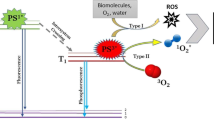Abstract
The aim of this study was to propose the use of red light-emitting diode (LED) as an alternative light source for methylene blue (MB) photosensitizing effect in photodynamic therapy (PDT). Its effectiveness was tested against Staphylococcus aureus (ATCC 26923), Escherichia coli (ATCC 26922), Candida albicans (ATCC 90028) and Artemia salina. The maximum absorption of the LED lamps was at a wavelength of 663 nm, at intensities of 2, 4, 6 and 12 J.cm−2 for 10, 20, 30 and 60 min of exposure, respectively. Assays with and without LED exposure were carried out in plates containing MB at concentrations of 7 to 140.8 μM for microorganisms and 13.35 to 668.5 μM for microorganisms or microcrustaceans. The LED exposure induced more than 93.05%, 93.7% and 93.33% of growth inhibition for concentrations of 42.2 μM for S. aureus (D-value=12.05 min) and 35.2 μM for E. coli (D-value=11.51 min) and C. albicans (D-value=12.18 min), respectively after 20 min of exposure. LED exposure for 1 h increased the cytotoxic effect of MB against A. salina from 27% to 75%. Red LED is a promising light device for PDT that can effectively inhibit bacteria, yeast and microcrustacean growth.
Similar content being viewed by others
Explore related subjects
Discover the latest articles and news from researchers in related subjects, suggested using machine learning.Abbreviations
- CFU:
-
colony-forming unit
- IC50:
-
inhibition of 50% growth
- LED:
-
light-emitting diode
- MB:
-
methylene blue
- MHB:
-
Mullen-Hinton broth
- %T:
-
percentage of transmittance
- PDT:
-
photodynamic therapy
References
Borissevitch I E and Gandini S C M 1998 Photophysical studies of excited-state characteristics of meso-tetrakis (4-N-methyl-pyridiniumyl) porphyrin bound to DNA; J. Photochem. Photobiol. B: Biol. 43 112–120
Calzavara-Pinton P G, Venturini M and Sala R 2005 A comprehensive overview of photodynamic therapy in the treatment of superficial fungal infections of the skin; J. Photochem. Photobiol. B: Biol. 78 1–6
Carballo J L, Hernández-Ida Z L, Pérez P and García-Grávalos M D 2002 A comparison between two brine shrimp assays to detect in vitro cytotoxicity in marine natural products; BMC Biotechnology 472 2–17
Hostettmann K 1991 Assays for bioactivity; in Methods in plant biochemistry (eds) P M Dey and J B Harbarne (London: Academic Press) pp 6–9
Kinghorn A D, Harjes K K and Doorenbos N J 1977 Screening procedure for phorbol esters using brine shrimp (Artemia salina) larvae; J. Pharm. Sci. 66 1362–1363
Lambrechts S A G, Aalders M C G and Van Marle J 2005 Mechanistic study of the photodynamic inactivation of Candida albicans by a cationic porphyrin; Antimicrob. Agents Chemother. 49 2026–2034
Levy J G 1995 Photodynamic therapy; Trends Biotechnol. 13 14–18
Livermore D M 1990 Antibiotic replace and transport by bacteria; Scand. J. Infect. Dis.-Suppl. 74 15–22
Machado A E H 2000 Photodynamic therapy: principles, potential of application and perspectives; Quimica Nova 23 237–243
Mang T S 2004 Lasers and light sources for PDT: past, present and future; Photodiagnosis Photodynamic Therapy 1 43–48
McLaughlin J L, Rogers L L and Anderson J E 1998 The use of biological assays to evaluate botanicals; Drug Inf. J. 32 513–524
Panda K and Chakraborty A K 1997 Studies on the interaction of bacterial lipopolysaccharide with cationic dyes by absorbance and fluorescence spectroscopy; J. Photochem. Photobiol. A: Chem. 111 157–162
Phoenix D A, Sayed Z, Hussain S, Harris F and Wainwright M 2003 The phototoxicity of phenothiazinium derivatives against Escherichia coli and Staphylococcus aureus; FEMS Immunol. Med. Microbiol. 39 17–22
Souza S C, Junqueira J C, Balducci I, Koga-Ito C Y, Munin E and Jorge A O C 2006 Photosensitization of different Candida species by low power laser light; J. Photochem. Photobiol. B: Biol. 83 34–38
Sternberg E D and Dolphin D 1996 Pyrrolic photosensitizers; Curr. Medicinal Chem. 3 293–324
Sternberg E D, Dolphin D and Bruckner C 1998 Porphyrin-based photosensitizers for use in photodynamic therapy; Tetrahedron 54 4151–4202
Sud I J and Feingold D S 1981 Heterogeneity of action mechanisms among antimycotic imidazoles; Antimicrob. Agents Chemother. 20 71–74
Tardivo J P, Giglio A D, Paschoal L H C, Ito A S and Baptista M S 2004 Treatment of melanoma lesions using methylene blue and RL50 light source; Photodiagnosis Photodynamic Therapy 1 345–346
Tardivo J P, Giglio A D, Oliveira C S, Gabrielli D S, Junqueira H C, Tada D B, Severino D, Turchiello R F and Baptista M S 2005 Methylene blue in photodynamic therapy: from basic mechanisms to clinical applications; Photodiagnosis Photodynamic Therapy 2 1–17
Usacheva M N, Teichert M C and Biel M A 2001 Comparison of the methylene blue and toluidine blue photobactericidal efficacy against Gram-positive and Gram-negative microorganisms; Lasers Surg. Med. 29 165–173
Usacheva M N, Teichert M C and Biel M A 2003 The role of the methylene blue and toluidine blue monomers and dimers in the photoinactivation of bacteria; J. Photochem. Photobiol. B: Biol. 71 87–98
Wainwright M 1998 Photodynamic antimicrobial chemotherapy (PACT); J. Antimicrob. Chemother. 42 13–28
Wainwright M and Crossley K B 2002 Methylene blue — a therapeutic dye for all seasons; J. Chemother. 14 431–443
Wainwright M, Phoenix D A, Marland J, Wareing D R A and Bolton F J 1997 A study of photobactericidal activity in the phenothiazinium series; FEMS Immunol. Med. Microbiol. 19 75–80
Weishaupt K R, Gomer C J and Dougherty T J 1976 Identification of singlet oxygen as the cytotoxic agent in photoinactivation of a murine tumor; Cancer Res. 36 2326–2329
Wilson M and Mia N 1993 Sensitization of Candida albicans to killing by low-power laser light; J. Oral Pathol. Med. 22 354–357
Zeina B, Greenman J, Purcell W M and Das B 2001 Killing of cutaneous microbial species by photodynamic therapy; Br. J. Dermatol. 144 274–278
Author information
Authors and Affiliations
Corresponding author
Rights and permissions
About this article
Cite this article
Peloi, L.S., Soares, R.R.S., Biondo, C.E.G. et al. Photodynamic effect of light-emitting diode light on cell growth inhibition induced by methylene blue. J Biosci 33, 231–237 (2008). https://doi.org/10.1007/s12038-008-0040-9
Received:
Accepted:
Published:
Issue Date:
DOI: https://doi.org/10.1007/s12038-008-0040-9




